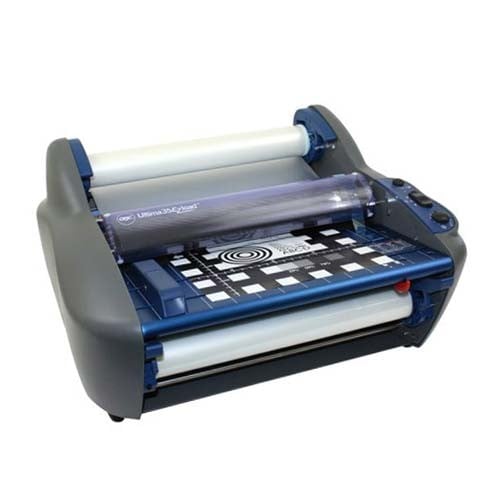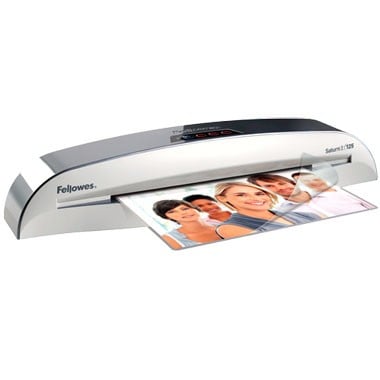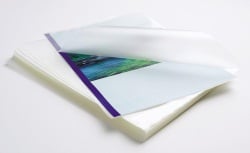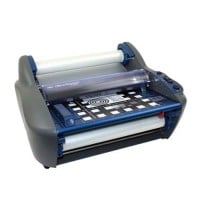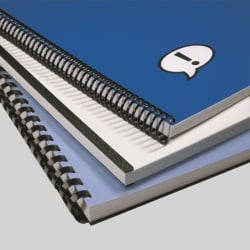MyBinding Knowledge Base
- Binding (248 Article)
- General Binding (42)
- Plastic Comb Binding (57)
- Fastback Binding (59)
- Perfect Binding (2)
- Modular Punching (8)
- Zipbind (3)
- Twin Loop Wire (13)
- Coil Binding (22)
- Thermal Binding (14)
- Strip Binding (1)
- VeloBind (4)
- Binding Covers (14)
- Proclick Binding (10)
- SureBind (4)
- Screw Post (2)
- Hole Punches (2)
- Staplers (4)
- Komtrak Insprial Binding (2)
- Paper (1)
- Rhin-O-Tuff (5)
- Binding Machines Comparison (17)
- Laminating (109 Article)
- General Laminating (26)
- Roll Lamination (16)
- Pouch Lamination (36)
- Pouch Board Laminator (3)
- School Laminator (3)
- Foil Laminating (3)
- Royal Sovereign Laminators (10)
- Laminators Comparison (3)
- Boards (11 Article)
- Bulletin Boards (3)
- Whiteboards (5)
- Chalkboards (1)
- Paper Shredders (44 Article)
- General Shredding (35)
- Industrial Shredders (1)
- Cross-Cut Shredders (2)
- Cardboard Shredders (1)
- Multimedia Shredders (1)
- Personal Shredders (1)
- High Security Shredders (2)
- Ring Binders (9 Article)
- Specialty Binders (2)
- Reinforced Paper (1)
- Health Care Punched Paper (1)
- Perforated Paper (2)
- View Binders (1)
- Index Tabs (9 Article)
- Index Tab Dividers (2)
- Copier Tabs (4)
- Pocket Folders (1)
- Custom Index Tabs (1)
- Pre-Printed Index Tabs (1)
- Paper Handling (37 Article)
- Paper Folders (9)
- Paper Joggers (2)
- Guillotine Cutters (4)
- Rotary Trimmer (3)
- Electronic Paper Cutters (1)
- Corner Rounders (2)
- Paper Scoring (2)
- Paper Drill (2)
- Booklet Makers (3)
- Stack Cutters (1)
- Paper Handling Equipment Comparison (5)
- ID Accessories (12 Article)
- Badge Holder (1)
- Lanyards (8)
- Badge Reels (1)
receive
$5off
*On order $25 or more.
What are the options for perfect binding with the Fastback Model 9?
With the Fastback model 9 binding machine and Perfectback binding strips, you can bind professional looking paperback books right at your desktop. There are two types of Perfectback Lx-Strips. Which type of strip you should use will depend on what type of document you are binding. This article will talk about the two different types of Fastback LX Perfectback strips that are available and will talk about how you use each type of strip. It will also talk about the type of cover that you need to use these different types of binding strips.
Lx-Perfectback LF Strips
When it comes to Fastback Strips, LF stands for “Lay-Flat.” These strips create a book bind that lays flat when opened. The spine hinges free from the book block. This allows the book to open easily without creasing the spine. It also allows you to do the final binding without heat so you can use printing methods and cover materials that are heat-sensitive. Perfectback LF strips have two narrow bands of release paper, one on each side of the back of the strip. Once you have bound your document using your Fastback 9 binding machine (the same strips are also used on the Model 8 and 8x binding machines) you simply peel off the release paper and stick your bound book block inside your prefinished cover. If you need to, you can then trim the book down with a guillotine cutter.
Lx-Perfectback PS Strips
The other type of LX PerfectBack strip is called a PS strip which stands for “Pressure-Sensitive.” These strips have a full pressure-sensitive adhesive on one side of the strip, and a thermal plastic adhesive on the other side. The entire spine of the cover is completely bound to the book block. Then, the final binding is done without heat so you can use cover materials or printing methods that are heat-sensitive without worry. Pressure Sensitive strips have a narrow and a wide band of release paper on the back of the strip. The final results look like traditional softcover binding.
Your Cover
In order to produce a perfect bound book with either a Perfectback LF or PS strip you will need a cover for your book. After you have bound the contents of your book using your Perfect Back strip and the Fastback 9 you will then need to peel off the release liner and insert it into your cover. This requires you to have a pre-scored full wrap cover with a front, back and spine. In order to make this type of cover you will need to take a large sheet of paper and print it using a large format printer or copier. After your cover is printed, you will then need to use a scoring device such as the Fastback Scoring Machine to produce score lines in the cover and to create a spine for your book. Once your cover is scored, you then need to fold the paper along the score lines to create a box spine. After that, all that is left to do is stick your book block into the cover.
Finishing Your Document
Depending on the size of the perfect bound document that you have created it may be necessary to finish your book by trimming the top bottom and side of your cover. This is usually done using a large guillotine cutter. Using a guillotine cutter it is possible to trim your documents so that all of the pages are flush. However, it is important to remember not to trim too much or you will end up cutting off some of the content from your book.
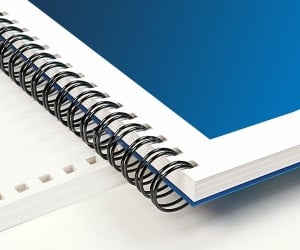
< Over the years, a number of customers have asked me whether they can use twin loop wire with their plastic comb binding machine. These customers often don’t want to have to buy a brand new machine but like the look and feel of twin loop wire binding. However, the answer to their question isn’t as simple as it seems. You see, they actually do make twin loop wire that is designed to work with the plastic comb binding hole pattern. With that said, if you want to use these wires you are going to need a way to close the wires. What is Spiral-O Wire? Let me explain a little bit more…There is a product that we carry called Spiral-O Wire. This wire has 19 loops and is designed to work with the hole pattern from a plastic comb binding machine. Spiral-O Wire is sometimes called Wire Combs or Ibico Wire and was originally designed for use with some of the older Ibico binding machines. A number of the older Ibico plastic comb binding machines also included a twin loop wire closer on the front of them to allow users to use both plastic combs and wire. This 19 loop wire was designed for this purpose. What Equipment is Needed? As the Ibico brand has been phased out by GBC and all of the older Ibico plastic binding machines have been replaced with new models, they no longer have the twin loop wire closer on the front of them. This presents a problem in trying to use these spiral-o wires since you can’t use the wires without a way to close them. One of the only options left is to purchase a Twin Loop wire closer. However, since twin loop wire closers are not incredibly cheap this option usually only appeals to users who have larger electric plastic comb binding machines. Otherwise, it is often advisable to simply buy a low end 3:1 pitch twin loop wire binding machine (the supplies are cheaper). This being said, if you have one of the older Ibico binding machines that has a wire closer included you are in luck. The Spiral-O binding supplies that we carry will work perfectly with your machine and you will be able to use both plastic combs and wire depending on your needs. These Spiral-O binding supplies are available in Black, Silver, White, Blue and Red and in sizes up to 1″ in diameter. If you aren’t sure what type of wire binding supplies that you need to work with your machine simply give us a call. Our trained sales representatives will be glad to help you find the correct supplies for use with your machine.(Read More)
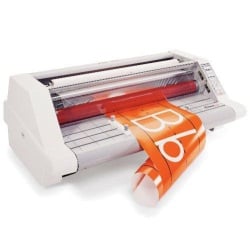

Loading...


